Advancing Science, Engineering, and Technology Policy
Initiative for Science, Engineering, and Technology
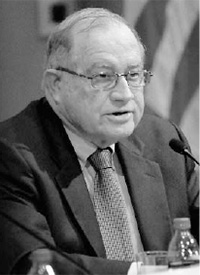
Neal Lane
Neal Lane is the Malcolm Gillis University Professor, Professor of Physics and Astronomy, and Senior Fellow at the James A. Baker III Institute for Public Policy at Rice University. He was elected a Fellow of the American Academy in 1994 and serves as Vice Chair of the Academy’s Council. He is also Cochair of the Academy’s Initiative for Science, Engineering, and Technology.
I am Cochair of the Academy’s Initiative for Science, Engineering, and Technology, and I am privileged to have Charles Vest, President of the National Academy of Engineering and former President of MIT, joining me as the other Cochair. The Initiative is an umbrella for several Academy projects in the science and technology policy area. You will hear about some of the current projects in just a moment, but let me mention others that we have recently completed.
The Academy organized a project to examine the teaching of science to non-science majors at U.S. colleges and universities. What are the goals of the science curriculum at liberal arts institutions? Are those goals appropriate? Are they being met? A study committee chaired by Jerrold Meinwald of Cornell University and John Hildebrand of the University of Arizona collaborated with provosts, deans, and others from institutions around the country, and the Academy published a volume, Science and the Educated American: A Core Component of Liberal Education, that included examples of best practices and recommendations for higher education leaders.
Another project flipped on its head a much-studied topic: public understanding of science. The Academy instead considered scientists’ understanding of the public. The capacity of scientists to secure funding, pursue laboratory work, and provide sound advice to policy-makers depends on an understanding of the social implications and likely public responses to their research. Through a series of case studies, this project brought together scientists, journalists, policy-makers, and others to explore these issues. The resulting paper, Do Scientists Understand the Public?, generated a great deal of press coverage and conversation in the science blogosphere.
One of the case studies from that project considered the importance of public attitudes in introducing new energy technologies. The examination of that topic led to a new Academy study, Social Science and the Alternative Energy Future, which Robert Fri and Kelly Sims Gallagher will discuss later. The process of one project leading into another area of study is typical of how Academy work evolves.
Let me say a word about why the Academy is, I believe, well suited to take on this work. The Academy is independent, which permits it the latitude to explore issues that the Fellows believe are important to pursue. Another distinctive feature of Academy studies is their interdisciplinary nature. By drawing on experts from virtually all academic disciplines, as well as leaders from the professions, public affairs, journalism, and the arts, the Academy brings a multidisciplinary, cross-institutional perspective to its examination of an issue.
In 2008, the Academy organized just such a cross-disciplinary group to assess alternative models for the federal funding of science. The group was chaired by Nobel laureate chemist Thomas Cech, who then headed the Howard Hughes Medical Institute, a position he subsequently left to return to research and teaching at the University of Colorado. There are regular calls from many quarters for more federal money for science and technology research. The Academy committee began its work with a different question: regardless of the size of the pie, what strategies can we adopt to maximize the impact of the government’s extensive investment in research?
After twelve months of work, our committee produced a report called Advancing Research In Science and Engineering, which has come to be known as the ARISE report. In answering the question – how to make federal support for science more effective – the committee chose to focus on two primary issues: support for early-career investigators and support for high-risk, high-reward research.
The first ARISE report had tangible impact in Washington. Our recommendations for targeted support of early-career investigators and for transformational research were contained in the stimulus legislation and in the Obama administration’s first two budgets. And key science and technology funding agencies have strengthened existing programs and adopted new ones to focus on early-career investigators and high-risk research.
The Academy organized a second phase of the ARISE project, which Keith Yamamoto, along with Linda Katehi and Leah Jamieson, will now describe.
Advancing Research in Science, Engineering, and Medicine: Creating an Innovation Ecosystem (ARISE II)
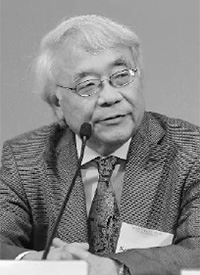
Keith Yamamoto
Keith Yamamoto is Vice Chancellor for Research, Executive Vice Dean of the School of Medicine, and Professor of Cellular and Molecular Pharmacology at the University of California, San Francisco. He was elected a Fellow of the American Academy in 1989 and serves as Cochair of the Academy’s ARISE II project.
I was a member of the ARISE I committee, and it was a terrific experience. As you heard from Neal, that committee chose two tight foci: support for new investigators and for transformative research. The ARISE II committee, which I cochair with Venkatesh Narayanamurti of Harvard University, has taken almost the polar opposite strategy, stepping back to look at the whole endeavor of research in science and engineering. It has set for itself a broad goal, nothing less than a consideration of the state of twenty-first-century science, engineering, and medicine in the United States, as well as an analysis of how those endeavors can best move forward.
To do this, the committee considered the historical set points that have taken the fields within science, engineering, and medicine to where they currently reside. And in doing that, we came to understand that the two sectors evolved rather separately – the physical sciences and engineering on one side and the life sciences and medicine on the other – and therefore they need to be approached separately, both to understand their current state and to envision how they can go forward. The physical sciences and engineering, as they evolved, always kept the full spectrum in front of them, from fundamental discovery to application. The life sciences, on the other hand, considered discovery and application to be separate. Basic discoveries in life sciences were considered ivory tower exercises in intellectual discovery and were not viewed as one step toward application. However, with the formation of Genentech in 1976, it suddenly became apparent that direct applications could come from fundamental discoveries in the life sciences. What has made the ARISE II project more than an interesting academic exercise is that the physical sciences and engineering and the life sciences and medicine now find themselves at exciting points not only in their own rights but also in terms of how they can integrate and begin to work together moving forward.
Many consider the twentieth century to be the century of physics and chemistry. (At least many scientists believe that.) It was defined by air travel, space exploration, the transistor, the electronics revolution, and so forth. The twenty-first century, according to some, may well be the century of biology: the sequencing of the human genome, understanding disease mechanisms at their core in ways that can be effective for treatment of individual humans, developments in agriculture and plant biology that are multiplying yields of crop plants, and so forth. But the grand opportunity, as perceived by the committee, is to recognize the interdependence and opportunities for synergy between the life sciences and medicine and the physical sciences and engineering – and then to create a balanced and functioning ecosystem that supports interdependence and synergy. Yet even with recognition, the integration can be uneasy, made more difficult by economic pressures, long-standing policies, and the complex interactions among the three key stakeholders in the research enterprise: academia, industry, and government.
The committee has focused on the interfaces between these three stakeholders insofar as they affect the shape of twenty-first-century science, engineering, and medicine. The interfaces that evolved in the twentieth century need to change, given where the fields have come and the new opportunities for bringing them together. Attention to the interfaces will better empower science, engineering, and medicine to address vexing societal issues of health, environment, food, energy, and so forth.
The committee is forming its final recommendations, and our report will examine the interfaces, consider drivers of change, determine what can best motivate movement in the right directions, and propose specific policy recommendations for each stakeholder group. The committee is looking with eyes wide open at a lot of sacred cows: in academia, tenure and promotion policies; in government, long-established policies that may in fact create perverse incentives and do damage along the way; in industry, retrenchment from early stage research that widens the “valley of death” for application of discoveries from academia.
As you might guess from the scope of this report, it could be complicated to put together a group that would not be beset with divisive opinions and conflicts. I think that is one of the unique characteristics of the Academy: that it can undertake a study of this breadth and depth and still have impactful recommendations because of its convening power, its multidisciplinary approach, and the fact that it is fiercely independent. What will emerge will be a report with substance and impact.
Advancing Research in Science, Engineering, and Medicine: Creating an Innovation Ecosystem (ARISE II)
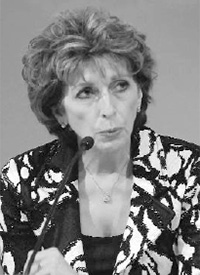
Linda P.B. Katehi
Linda P.B. Katehi is Chancellor, Professor of Electrical and Computer Engineering, and Professor of Women and Gender Studies at the University of California, Davis. She was elected a Fellow of the American Academy in 2011.
The ARISE II committee is looking at the collaborations between various stakeholders when it comes to innovation. One question that we asked was, why is it that at certain times in our history – during and after World War II, for example – we have been so successful in innovating and creating products with specific uses? In recent times, we have found this innovation ecosystem to be broken, and we have encountered multiple difficulties in trying to move from ideas to services and products.
Right after World War II, a particular ecosystem developed within industry; it was what we mean when we talk about vertical integration. The ecosystem was well sustained and comprised many elements all in the same environment: basic research, incentives for specific outcomes, and funding. Integration was optimized because decisions were made by the same organization. Bell Labs and IBM stand out as clear examples of the ecosystem I am describing. There was intent to develop a product and discipline in the process; there was a partnership between individuals doing fundamental research (but for a purpose) and those who would then take the ideas and produce something specific. The outcome of that process was phenomenal, leading to many technological innovations. A lot of industry and markets were developed because of those environments.
Today when we look at the ecosystem, we find that the connections between the various parts are broken. This is because many parts have moved to a variety of sectors. Funding is now dominated by the federal government, with many decisions made by that sector as well. Basic research groups are distributed throughout academia; there are now very few major laboratories in industry. Then, of course, we have the marketplace, which forms itself on the basis of what the need is and what the public wants. In the ecosystem we have today, the ability to move from one component to another is very difficult. Our inability to translate all the ideas we have into products or services is directly related to the difficulty in integrating basic research and translation (a problem that is especially difficult in the life sciences). And the integration between the period of translation and the eventual creation of products that are needed in the market – and the eventual creation of markets for these new products – is even more difficult to accomplish.
All the components of the ecosystem exist, but different players are making decisions about the various aspects of the ecosystem. With better integration, we will be able to succeed. One thing is for sure: we are not short of ideas, and we are not short of needs in this society. We must find the right way to connect the two.
Advancing Research in Science, Engineering, and Medicine: Creating an Innovation Ecosystem (ARISE II)
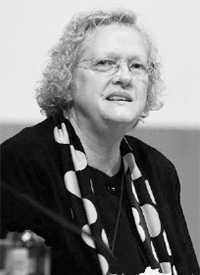
Leah Jamieson
Leah Jamieson is the John A. Edwardson Dean of the College of Engineering, the Ransburg Distinguished Professor of Electrical and Computer Engineering, and Professor of Engineering Education at Purdue University. She was elected a Fellow of the American Academy in 2011.
Keith and Linda have given a clear picture of some of the issues and have identified some of the drivers of change in the industry. They explored the changes in where research is being done and the granularity of the organizations in which a research problem is taken from conception, to research, then development, and on through to an actual product. Underlying all of this is a sense that the sustainability of the funding models for research is changing radically. There is enormous concern about the role of the federal government and its inclination to fund or not fund research, as well as recognition that there need to be alternative sources. We have to understand how universities and industry work together and then build on the leverage points for federal funding or other sources of funding.
The committee’s recommendations are still being developed, but they all stem from the assumption that industry and universities across all the sectors of the life sciences and medicine and the physical sciences and engineering must work together in constructive ways, maintaining a flow across the scale of basic to applied research. On the industry side, this will affect how one thinks about conflict of interest, about intellectual property, and about the ability for people from industry to interact with faculty: for example, through resident appointments at universities that would allow collaborative research. We need to think about the depth and nature of that collaboration. Can people at universities do something more than work at the fringes of industry’s core problems? On the academic side, can we recognize multidisciplinary work? Can we recognize contributions on the applied side, some of which may be shrouded by confidentiality agreements because of industry partnerships? These questions have implications on the value system, rewards system, promotion, tenure, technology transfer, and, again, intellectual property rights. The ARISE II study is focused on science and engineering, but it in fact has implications across entire academic institutions, because change will not happen in a vacuum.
For me, the process of serving on this committee has been enlightening. We came together from all these sectors – industry, academia, government – with very different backgrounds, histories, records of funding models, industry interactions, and kinds of institution. The first three meetings of the committee might best be described as chaotic. We had to understand each other’s problems. We had to suggest other people who could come in to articulate either the challenges or successes they had faced. But understanding did grow among the committee members, and what is now coming together is a very coherent whole, with a depth of appreciation of different histories but a vision for a shared future.
International Agreements on Internet Protection
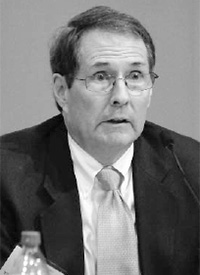
John D. Steinbruner
John D. Steinbruner is Professor of Public Policy at the School of Public Policy and Director of the Center for International and Security Studies at the University of Maryland. He was elected a Fellow of the American Academy in 1992 and serves as Cochair of the Academy’s Committee on International Security Studies.
The spontaneous development of the Internet has made it vulnerable to the potential for intrusion and destruction or disruption of critical social services. The considered judgment at the moment is that these vulnerabilities can be mitigated but not removed by technical means, and that no single sovereign entity is a plausible source of unique protection. So we have an international problem on our hands. The spontaneous process of protection of the Internet has so far been sufficient to hold exploitation within tolerable bounds (a lot of stealing of information goes on, but it is not intolerable) and to prevent the massive acts of disruption and destruction that are, in principle, conceivable. That process is enabling a global public service or public utility to emerge, intruding in the daily lives of virtually everyone.
The question is, will this spontaneous process of protection be indefinitely sufficient, or will it ultimately require globally organized protection at a much higher level than now exists? The Academy’s project on International Agreements on Internet Protection is designed to examine the latter alternative, conceding that the former is also arguable. We are looking at the possibility that globally organized protection will prove to be necessary. It is not too hard to figure out the requirements for serious protection, but coordination would have to be global in scope, meaning it would have to be sponsored in some way by the United States, Russia, and China, the major players in this situation. Protection would have to be narrowly focused; it could not account for everything that one worries about, but rather would focus on acts of destruction or massive disruption directed at critical social assets, including power grids, air traffic control systems, financial clearing processes, emergency response operations, and health care delivery. The ingredients of global protection, if one imagines an arrangement that would provide serious protection, would have to begin with the categorical legal prohibition of destructive acts targeted at social infrastructure operations. I would argue that the power grid is likely to be the test case in this regard. In addition to legal prohibition of destructive acts, there would have to be common standards of protection involving rules for authenticating source codes and probable separation from the normal Internet. It would take a lot of organization to bring that about: there would have to be compliance monitoring as well as criminal enforcement of these arrangements conducted on a global scale.
The impediments to such an arrangement are obvious. There is serious suspicion and recrimination among the major players – China, Russia, and the United States. We all are accusing each other of maliciousness of various kinds. In order to untangle that and face it head on, we must engage much broader security subjects, such as the confrontational disposition of nuclear and conventional forces and the legacy policies and attitudes associated with that; and the fear of or allegations of use of the Internet for hostile political intrusion into domestic processes. (China, in particular, is sensitive to this latter point, but Russia is as well.)
The danger if we do not overcome these impediments is the development of highly destructive offensive missions by the United States, Russia, and China. Each would cite the other as a justifiable threat; action would be driven by mutual suspicion, not inherent interest. The practical situation is reminiscent of what was faced immediately after World War II, when there was an effort to imagine how global management of nuclear technology might be imposed to avoid massive deployment of nuclear weapons. We pretty much preemptively declared that effort to be unfeasible, and we did not test whether it would have been possible to achieve global standards of protection. We do not want to make the same mistake. Whether or not it can be done, we certainly want to imagine a serious effort toward ensuring protection.
As a practical matter, an official initiative is very unlikely to emerge from the governments at the moment. They simply are not devoting serious enough attention to this topic. But the U.S. government at least has called for detailed public discussion, implying that it cannot operate until society has a better idea of what it wants to do. The Academy’s study can be a vital part of that public discussion.
Protecting the Internet as a Public Commons
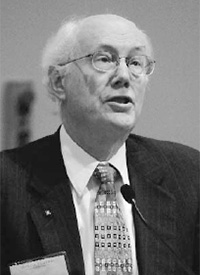
David D. Clark
David D. Clark is a Senior Research Scientist at the MIT Computer Science and Artificial Intelligence Laboratory. He was elected a Fellow of the American Academy in 2002.
The Academy has had a long interest in security, which has historically been centered around arms control, but which has led to interest in cybersecurity as a potential topic of consideration. The recent issue of Dædalus that I guest edited, “Protecting the Internet as a Public Commons,” draws on the Academy’s longtime interest in security topics.
Much of the rhetoric around cybersecurity today focuses on the potential for intense conflict, leading to the use of terms such as cyberwar. I’m sensitive to the potential of a major cyberevent that could have catastrophic consequences, but I think for most users, the metaphor of cyberwar is a bit shrill. I do not wake up in the morning and wonder whether today is the day that I’m going to be the incidental victim of a cyberattack any more than I worry about today being the day my house is overrun by Cossacks. Most Internet users are concerned about less dramatic but more prevalent issues that define the Internet experience as the user perceives it: Is my credit card number going to be stolen? Is my identity going to be stolen? Is today the day that some malicious software on my computer is going to send a spam advertisement for knockoff Viagra to all my friends? You may suffer intense embarrassment.
This issue of Dædalus looks at the experience of using the Internet. What do we use it for? Why do some of us not use it? What concerns limit our use? What features shape its use? The question of why some of us do not use the Internet is an important and revealing one. John Horrigan’s contribution to the volume reports data from the Pew Internet & American Life Project and data gathered by the Federal Communications Commission. Almost a quarter of American homes surveyed report that they do not use the Internet. One reason is cost, which of course relates to perceived value: if they thought of the Internet as valuable, then it would be worth paying for. But a major reason was fear of “bad things” happening on the Internet. Horrigan’s paper makes an important point: as more and more activities move online – for example, applying for jobs – non-users are more and more disenfranchised. This fact should be a major concern to us as a society. We need to try to mitigate the barriers and concerns that limit usage.
Loss of privacy is a recognized concern. Many websites offer long privacy policies that prospective users are required to review and accept on a “take it or leave it” basis. I’m sure many of you have done this. The paper by Helen Nissenbaum in the Dædalus issue argues that the current approach is fundamentally flawed. She observes that in the real, or offline, world we do not have such documents. You did not sign a privacy policy when you came into this auditorium today. Our expectations are shaped by well-understood conventions that arise in particular contexts. We have norms, and we have regulations around health records, commerce, tax returns, library catalog searches, overheard conversations in restaurants that you are supposed to pretend not to hear. In this respect, the term cyberspace is misleading because it suggests that online behavior occurs in a unique and different space, with unique and distinctive norms. Nissenbaum argues that most online behavior has a strong analogue in the real world. We should not depend on long privacy agreements to define the set of expectations on the parties; we should understand the context in which the arrangement occurs and the norms and expectations that arise in that context.
Other papers in the volume look more specifically at the issue of security. A paper by Deirdre Mulligan and Fred Schneider puts forward a proposition that the way to think about network security is by analogy to public health; they argue that we need a doctrine of public cybersecurity. Another set of papers looks at the ways we choose to use the Internet. Kay Schlozman, Sidney Verba, and Henry Brady caution that the Internet does not seem to have changed the nature of U.S. political engagement. Despite hopes that the Internet might be the great leveler in political engagement, they find that political activity online more or less follows established trends in traditional offline political activities.
One can draw a number of conclusions and observations from this collection of papers. In a global world with little global policing, the means by which bad behavior is controlled and stable, harmonious interaction is fostered must largely come from within an experience and not from without. Software defines the rules of engagement that create various online user experiences, whether that be on Facebook, eBay, or email. The Internet is a built artifact, and we can change the rules of engagement if we are only smart enough to know how. Viewed in this way, security is not a technical problem that calls for a technical fix but a socio-technical issue that is a balancing act among conflicting objectives. For example, identity is a component of developing trust among users, and it is a means of disciplining bad actors. It does not make sense to talk about whether you trust one person more than another if you cannot tell who anyone is because everyone is running around with a bag on his head. On the other hand, mandatory revelation of identity would have tremendously chilling effects. Imagine if you were required to walk around with your name, address, and phone number written in large characters on a placard for all to see. This is not a better option than having a bag on your head. Matters of identity and trust are nuanced aspects of the social fabric, as some of the papers in the Dædalus issue make clear.
We should not just accept the Internet as it is, but should ask how it might be made differently and better. And we should ask who is building the Internet today and what their motivations are. In the early days, we were a bunch of government-funded researchers. We did not quite know what we were doing, but we were trying to build a global platform for society. Most of the investment today comes from the private sector, which, not surprisingly, designs systems and user experiences with an eye toward revenue generation. That driver of progress is fine, but in my view it should not be the only driver for the future of the Internet. Several of the Dædalus essays make the point that different futures, with very different social implications, are up for grabs. One of the questions we should ask is, how can we cause the Internet we want for society to come into being?
The Humanities and Intellectual Life
The Importance of the Humanities and Knowledge
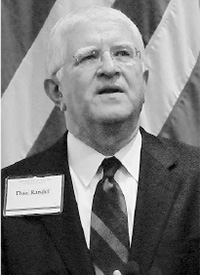
Don M. Randel
Don M. Randel is President of The Andrew W. Mellon Foundation. He was elected a Fellow of the American Academy in 2001.
These are not particularly happy times for the nation’s intellectual and cultural life, and in fact, we are witnessing what amounts to a massive disinvestment in that life. If you think about the context for this state of affairs, and about the circumstances in the past when we did make investments, one is bound to conclude that our current situation rests on facts about our national temperament. We are a nation with a practical turn of mind, a well-developed anti-intellectual streak, an underdeveloped memory, and a focus on the future.
Investments in the national intellectual life have mostly been justified on one of three bases: if they contribute to the gross domestic product, if they contribute to the national defense, or if they help increase the life span of human beings. But what are the values associated with those commitments, and what might be the deficits among those values? If we make contributions to the gross domestic product, we ought to be concerned about whether the profits from those investments are distributed equitably across society. If we wish to justify the national defense, you would hope that this would be accompanied by real knowledge of the cultures and traditions of other peoples, especially those with whom we might plan to go to war. Perhaps, too, we should know something about the languages and cultures of the people we would hope to be our allies in any such adventure. Yet these two forms of knowledge have been underrepresented in our foreign policy. And finally, we like to invest now, and we have been quick to increase investment in the biomedical sciences for the sake of extending the human life span. We need to think also about how to make the benefits of this investment available to a much broader spectrum of society, not just the well-to-do.
What is lacking is not so much a concern about the value proposition of our investment in the intellectual life of the nation; rather, it is the values proposition in our investment – and that is the domain of the humanities and the arts. When we invest in efforts to increase the human life span, we ought to be concerned about why it is that one would want to be a human being in the first place. In thinking about that question, I cannot help but recall the lines from William Carlos Williams’s poem “Asphodel, That Greeny Flower”: “It is difficult / to get the news from poems / yet men die miserably every day / for lack / of what is found there.”
How does one make a strategy out of that? What should any of us, or the Academy as a whole, want to do about that? Of course, instrumental arguments can be marshaled in support of the humanities and the arts; one can think of many practical reasons why the study of history, the study of the humanities, and the making of art are valuable. Indeed, supporters of the arts are currently bearing down very hard on the instrumental argument. Bring arts to the inner city and it will be good for business, they say. People will come in from the suburbs; they will hire babysitters; they will use parking lots and tip the parking attendants; they will tip the waiters. All this may create economic activity, but it misses the point of thinking about why human beings make art in the first place. In this context, it is important to remember that there really are not two cultures, as has sometimes been proposed. There is really only one.
Scientists do science for the same reason that artists make art, for the same reason that humanists engage in humanistic scholarship, and it is because they cannot help it. We all are born with a marvelous capacity to ask questions, a desire to explore what is unknown or what is imperfectly known. One of the main problems with our schools today is that we beat this curiosity out of young people. We must not pursue the instrumental argument (though it would be nice to pursue it); instead, we must come back to the values that underlie the human pursuit of more or less anything worth pursuing.
When talking about the humanities, we are not really dealing with a question of funding. The National Endowment for the Humanities (NEH) has a budget, if it continues to exist at all, of about $150 million, a pathetic sum that is approximately equal to the cost of one F22 airplane. (The Department of Defense doesn’t even want any more of those planes, but some piece of that plane is made in nearly every congressional district in America. So, needless to say, there are those who think the Defense Department ought to have the planes.) Careful students of our defense budget will wonder why I’m talking about the F22, since it is being discontinued. Why don’t I speak about the F35 Lightning Joint Strike Fighter? We do not yet know what that plane will cost, but we are sure that we need it. So it is not a matter of going to Congress to argue for a doubling of the NEH budget, or the National Endowment for the Arts budget, because it would not amount to very much even if we did. But there comes a moment when all of us – scientists, humanists, artists, social scientists – need simply to stand up and claim some space in the national dialogue. Even if it does not lead to an increase in any one organization’s budget (though one can think of lots of things to spend money on), we have to be willing to say to the public as vigorously as we can, “What is it that we think is important about life? What should human beings aspire to? How can we make the life of the mind richer for everyone in society?”
The Academy is a wonderful place to frame such a discussion, to bring together people of diverse interests, to try to claim that space in the national dialogue, and that is why the Mellon Foundation is very happy to support the Academy’s efforts in this respect. I look forward to learning the outcome, to listening in on the conversation from time to time, and to hearing what all of you will contribute.
The Importance of the Humanities and Social Sciences
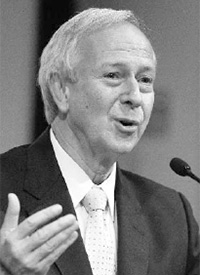
Richard H. Brodhead
Richard H. Brodhead is President and Professor of English at Duke University. He was elected a Fellow of the American Academy in 2004 and serves as Cochair of the Academy’s Commission on the Humanities and Social Sciences.
The Academy having envisioned it, Congress having requested it, and the Mellon Foundation having partly funded it, a team was pulled together last winter that, in imitation of the adventure film Ocean’s Eleven, might be called Berlowitz’s Fifty. Of those asked to serve on the Commission on the Humanities and Social Sciences, most accepted instantly and only two or three declined. Why: because it was clear what we would accomplish? No; because it was clear that something was at stake.
The foundational modes of knowledge are strongly represented in this room, but they are weakly appreciated in our culture, and failing to provide for them exacts a collective cost. Math and science are not yet off the endangered list, but they have had their claim advanced for them in a very compelling way. In the last six or eight years, the meaning of STEM education for national competitiveness and national security has become a truth universally acknowledged, repeated in almost identical language from State of the Union addresses to PowerPoint presentations delivered at local civics groups.
But no one ever thought that STEM comprised the whole of valuable knowledge, still less that American accomplishments in other fields were in any way more reassuring. (As Norm Augustine has underlined, the poorest level of educational accomplishment registered in the National Assessment of Educational Progress by American fourth, eighth, and twelfth graders is in history.) What drew members to this Commission is the challenge of making a comparably persuasive case for trans-STEM subjects and skills.
This is a fun task but not a trivially easy one. At our first meeting, the interplay of thirty passionate and articulate intellects did a splendid job of opening up the subject. It’s too soon to say where we will come out, but in this first pass, certain general and crucial agreements did become clear.
First, while the title of this Commission implies a familiar map of intellectual divisions, we are committed to connections and integrations, and against every fiction of separation. We do not conceptualize the humanities and social sciences as the list of departments placed in these divisions in arts and sciences faculties. We see them as including every form of expressive creation and human collectivity, from speaking and writing to the arts, to religion and law, to cultures, systems of value and systems of exchange.
Second, we are not interested in pitting the humanities against the sciences or promoting ourselves as STEM’s poor but virtuous relation. The group’s core belief is in the liberal arts conception of knowledge that incorporates arts and sciences: a broad, integrative education that develops multiple modes of knowledge and promotes connectivities among them.
Third, we want to escape from false choices over forms of validation. Perhaps you have noticed: the humanities have not created a mass following by presuming appreciation of their unique intrinsic value. For this reason, those keen to build support reach for other kinds of arguments, among them: the single skill employers value most highly is communication. Or, learning to connect previously unconnected things is the way to creativity and thus the key to innovation and economic success. Or, arts are a key driver of regional economic growth. Or, how can we navigate a globalized world if we don’t understand foreign languages, cultures, histories, and values? Or, how can we train citizens for our own multiculture if we don’t develop the ability to enter into others’ points of view?
Many humanists feel that it betrays their work’s value to argue for its social utility, and I will testify that if you have not felt how these subjects expand awareness, furnish the mind, and feed the soul, you don’t yet get their power. But if we want to win broader appreciation, we need to sharpen every possible argument in the arsenal of persuasion, not make finicky choices among them. Preaching to the choir will be fine when the need to build the congregation has passed.
Fourth and very quickly: the humanities suffer from the segmentation of their support. No one grows in these powers who is not awakened early and subjected to early training, so the early chapters of education require our special concern. But in this country, those who work in K-8 education, in high schools, in undergraduate colleges, in graduate training, in institutions that support lifelong education – the media, cultural institutions, community organizations – have all been far too isolated from one another, with little sense of shared goals and of how they might pool their resources. To build a more coherent source for powers that require lifelong exercise, we need to find better ways to connect the points.
The bad news is that we can’t take for granted that the general population knows or cares about these mental provinces to the extent that our social health requires. The good news is that curiosity is the defining attribute of our species, and there is an immense public appetite for the humanities if it could be successfully tapped. It’s heartening that the non-academics on this Commission have been among the most articulate champions for the forms of mind the liberal arts can develop. Now we need to work to build the irresistible case.
The Importance of the Humanities and Social Sciences
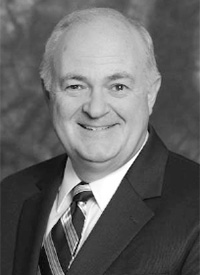
Steven Knapp
Steven Knapp is President of The George Washington University. He was elected a Fellow of the American Academy in 2011.
One advantage enjoyed by a university located in Washington, D.C., is the opportunity to host discussions of national and international issues. In recent years, the George Washington University has had the privilege of hosting the Academy with some frequency. In fact, the Academy has been coming to our Foggy Bottom campus for a number of years to participate in the annual meeting of the National Humanities Alliance, which is then followed by a day of advocacy in the halls of government.
This past May, we hosted a fascinating workshop on ways to bring the social sciences to bear on the cultural and social obstacles to the adoption of new energy technologies. The workshop was part of the Academy’s Alternative Energy Future project, and it is one of many examples of how the Academy not only proclaims but demonstrates the relevance of the humanities and social sciences to the flourishing of this nation and the world beyond it. But why is it necessary either to proclaim or to demonstrate the relevance of the humanities or the social sciences?
I want to focus on the humanities and offer just two reasons, one with ancient and the other with very recent causes. The first, the ancient one, is the doubt that work in the humanities counts as a source of real or useful knowledge. This thought goes back at least as far as Plato’s dialogue “Ion.” Ion is a rather hapless professional reciter of poetry, whom Socrates badgers into admitting that poetry does not contain any generally useful knowledge because poets don’t really possess any genuine expertise; they merely mimic those who do. If we were to update Socrates’ critique, we might say something along the following lines: the content of poetry, or the humanities more generally (and to a lesser extent the social sciences), is bound to the particularities of historical context and the lived experience of the occasions that prompt curiosity in the first place, whereas the natural sciences aim at general explanatory laws, whose power does not depend on the particularity of the objects or phenomena that stimulate scientific inquiry. Scientists may initially be stimulated by particular phenomena, but they transcend those phenomena as they develop general ways of explaining them.
The trouble for humanities scholarship in particular is that the more scientific humanities scholarship becomes – that is, the more it strives for general explanatory power – the further it seems to depart from the culturally prestigious objects and events that originally provoked the scholar’s interest. This fundamental difference between the logic of scientific and humanistic curiosity is something that I have elsewhere called “the enduring dilemma of the humanities,” and it is a challenge that the Academy has been working on, one way or another, since its origin more than 230 years ago. John Adams, around the time that he was envisioning the Academy, remarked that he was hopeful that after a generation focused on war and politics, the American people would be freed to focus on science and engineering, which, in turn, would free the third generation to focus on the humanities. (He went on to list a set of humanities fields that culminated in porcelain!)
The enduring dilemma is always in the background; it is nothing new. A proxy for the second, more recent challenge is what the media like to call the decline of reading. A series of studies published with great fanfare by the National Endowment for the Arts (NEA) has appeared to show, first, a precipitous decline in literary reading and then, over the course of the past decade, a surprisingly rapid recovery. The data and its interpretation, however, are far more complex and controversial than that summary statement would suggest. Some would argue that the so-called decline was really a shift from books and articles to blogs and other items available online. Others would point out that the recent rise in the number of adults reading prose fiction was accompanied by a continuing decline in the readership of poetry and drama. One striking figure in the NEA’s 2009 study is that the percentage of American adults who do not read even a single book in the course of a year that is not required by their job or school has risen to 45.7 percent.
My own view is that, thanks to the Internet, we will continue to read more and more, but that the practice of slowly, carefully reading any extended discourse, literary or otherwise, in book or article form will continue to decline. That decline is both the cause and an effect of a far more troubling decline: a decline in the skills and, equally important, the habits of long-term reflection on the nature and conditions of human existence – reflection on what corporations would call the opportunities and challenges that face our species, or what poets would call our joys and sorrows. And that’s why it matters, after all, to have a body with the collective intellectual weight of the American Academy of Arts and Sciences, not only to make the case for but actually to exemplify the kind of careful study and long-term reflection that really do seem to be slipping away from the habits of our society.
The Importance of the Humanities and Social Sciences
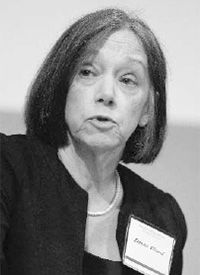
Diane P. Wood
Diane P. Wood is a Federal Judge on the U.S. Court of Appeals for the Seventh Circuit and a Senior Lecturer at the University of Chicago Law School. She was elected a Fellow of the American Academy in 2004 and serves as a member of the Academy’s Trust, Council, and Midwest Regional Committee.
I want to offer a more pragmatic view of what I hope this Commission will be able to achieve. I go back to the fact that it was created at the bipartisan request of Senators Lamar Alexander and Mark Warner and Congressmen Tom Petri and David Price. It was very gratifying to have them say, “We believe this matters. We believe this will make a difference to the future competitiveness of the United States, to the future of the United States as a coherent society.” It should be music to all our ears to know that people in Congress are thinking about these matters. They gave us a challenge: “Tell us what we can do to make a difference. How can we move this forward? Give us a top ten list.”
We all would probably agree with the premise that there is intrinsic value in the humanities, and Don Randel already mentioned the fact that people make instrumental arguments for the humanities. In my mind, I divide the arguments between those for bringing the humanities more effectively to the population as a whole – the supply side or the training side, if you will – and those for helping people understand why the humanities are something they should want, whether intrinsically or otherwise. On the supply side, there is a question of where and how we are going to accomplish the necessary training, and so the Commission thought of dividing our task by age group. The usual breakdown includes the K-12 group, undergraduates at four-year colleges and universities, and graduate students; but we also wanted to remember the places in our educational landscape that are often forgotten. Not everyone goes to one of the universities represented at this table or to the places where many of you went. Many of our fellow citizens wind up with no college training at all, or they attend a community college or vocational school. Professional schools also deserve attention. One of the members of the Commission is the dean of a business school; if we are to secure the role of the humanities throughout our educational system, then we must remember advanced professional studies. Yet even those at four-year colleges might say, “I’m an engineering major, I haven’t looked at a book that wasn’t about engineering since I was a junior in high school.” We do not want that to be the case, and so we are looking at the whole spectrum of education levels and types of institutions.
We also considered community outreach, asking the question: what ought to be within everyone’s core competence? There was some talk about the basic subjects that should be treated, whether history, social science, or English. One member of the Commission suggested that we should apply to ourselves the “Wal-Mart test”: can you tell someone in the checkout line at Wal-Mart why it is what we are doing is important?
On the demand side, we have to recognize that there is a disconnect between experience and the value of the humanities. Several members of the Commission suggested a fresh vocabulary. I hate to be frivolous, but when you talk about “liberal arts,” each word in that phrase is scary for some people: Liberal? We don’t want to do that! And what are the arts for? Someone suggested “fully balanced curriculum,” which may not be perfect but does suggest a new direction.
John Rowe, Cochair of the Commission, was asked, “What do you as a businessperson value? Would you hire somebody with this background?” He said both of the things that you might expect: “Yes, we in business value the humanities a great deal; but no, we don’t want to hire somebody who can’t add or who otherwise is not competent in some business field we need.”
The Academy is absolutely the right place for this study because we are in a position not only to think about the humanities by drawing on the very broad expertise of Academy members, but also to realize that the humanities will not stand alone. As Dick Brodhead said, we aim to achieve a balance – a linking of the humanities, the sciences, and the other disciplines for the proper functioning of society.
The Importance of the Humanities and Social Sciences
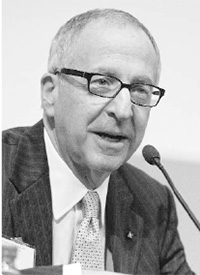
David J. Skorton
David J. Skorton is President of Cornell University as well as Professor in the Departments of Medicine and Pediatrics at Weill Cornell Medical College in New York City and in Biomedical Engineering at the College of Engineering on Cornell’s Ithaca campus. He was elected a Fellow of the American Academy in 2011.
I have three messages in my brief remarks. The first is that the Academy really is the place to conduct these kinds of messy but very important studies, because of its convening power, because of its fierce independence, and because we are not afraid to argue with each other behind the scenes.
With all due respect to Don Randel and others (I’m the only non-humanist on the panel, although, in reality, all physicians are humanists), I think it is important that we not only claim a space for the humanities, but claim some support for that space as well. I’m old enough to remember when the budget for the NEH was $175 million, which was its top. It was 50 percent or more of all the research funding available in the humanities in those days for college and university humanists. Now, because of decisions made by our elected representatives, this endowment has decreased 40 percent in inflation-adjusted dollars during the same years when the National Science Foundation budget has approximately doubled as has that of the National Institutes of Health. So the second of my three messages is that while we are trying to come to terms with what we mean and how we express it, I think that it is important that the NEH and NEA do not go out of existence. A Congressional study committee suggested that both endowments be zeroed out this year, but they were not. This was an important victory not so much because of that tiny bit of money that Don referred to but because of what it says about the idea that public money should go to support these areas, just as it goes to support the life and other sciences. My research career was in engineering and medicine, and so I believe those subjects are very important. But the subjects in the humanities and the arts are important, too – important enough to be supported by the taxpayer.
My third and last message is another instrumental reason that I think is very important; it is the reason that I take to the most conservative members of Congress. (Those are the only ones I talk to about this matter, because preaching to the choir is a time-wasting activity right now, when members of our elected bodies appear to be ready to really savage many programs.) I say to them: “When our intelligence agents collect information about those people whom we’re fighting around the world, they give that information to analysts, and those analysts are not predominantly physicists or molecular biologists or physicians. They’re humanists and social scientists. So if you want to sleep better at night, make sure that you give enough support to our great colleges and universities. Don’t forget to keep teaching the things that you want smart people to be analyzing so that you can sleep better at night.”
The Energy Future
The Alternative Energy Future
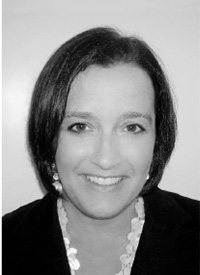
Kelly Sims Gallagher
Kelly Sims Gallagher is Associate Professor of Energy and Environmental Policy at the Tufts University Fletcher School, where she directs the Energy, Climate, and Innovation research program in the Center for International Environment and Resource Policy.
Thirty-eight years have passed since the first oil crisis, thirty-four since the National Research Council issued its first report on global climate change, and twenty-one since the first Intergovernmental Panel on Climate Change issued its first assessment report. The reasons for change in our energy system – national security or economic competitiveness come to mind – certainly persist, and in some cases they have grown more urgent: climate change, for example. Every American president since Richard Nixon has devised a plan for changing the U.S. energy system, almost all calling for energy independence, but each has failed to meet his objectives.
What has gone wrong, and why? The good news is that during the past four decades, the commercial availability of many advanced, efficient, and clean-air energy technologies has increased, and costs have fallen substantially for many of these technologies. In the United States at least, some aspects of our environment are cleaner, and we are experiencing better environmental quality. The bad news is that U.S. export competitiveness in alternative energy technologies has fallen behind Germany, Denmark, Japan, and even South Korea and China. The United States ranks 134th among nations in the overall energy efficiency of its economy. Greenhouse gas emissions in the United States appeared to have peaked in 2009, but they have rebounded in the last year and remain steadfastly above almost all other advanced economies in per capita or per GDP terms. And while the U.S. oil supply has become more diverse, oil imports currently account for 45 percent of the U.S. trade deficit.
The national energy system is resistant to change. Political will to devise ambitious and strategic energy policy is feeble, resistance from some interests is formidable, and the American public does not appear to pay much attention to energy policy. We have only a rough understanding of how society shapes the energy system, and how it, in turn, affects society. We know precious little about private-sector investments in energy innovation, and we know even less about how they intersect with or duplicate government investments. Furthermore, we do not understand the complex dynamics of individual household, community, corporate, or government energy decision-making processes. Consequently, many assumptions made by policy-makers in formulating new energy policy may be incorrect.
As we struggle to address all these energy-related challenges, we must balance our intellectual and financial investment in the physical and natural sciences and engineering with a commitment to the social sciences. The Academy is just the place to explore this topic. There is a pure interest in the social sciences here, and the Academy provides more flexibility and intellectual freedom to follow these issues where they go. It permits and, indeed, encourages interdisciplinary study, and gives us the ability to be entrepreneurial with the insights we have been developing.
The Alternative Energy Future
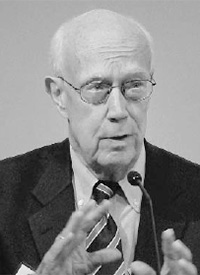
Robert W. Fri
Robert W. Fri is a Visiting Scholar and Senior Fellow Emeritus at Resources for the Future. He was elected a Fellow of the American Academy in 2010 and chairs the Academy’s Alternative Energy Future project.
If there is to be a gigantic transition in the energy system – to meet our needs for energy security, environmental protection, and climate change – there has to be a substantial societal transformation that would take place at the same time, both to allow the energy system to change and to adapt to a changed system. We began our project with an intellectual construct of some major issues about that societal transition. We planned to prepare white papers on those major issues and produce a volume of Dædalus around them, but once our plan met reality it collapsed.
Two things happened right after we began this project that created our version of chaos. One, climate policy collapsed. The idea of cap and trade, which looked favorable eighteen months ago, collapsed in the U.S. Congress. Meetings in Copenhagen that were supposed to produce the successor agreement to Kyoto also collapsed. Because climate policy was meant to be the major driver of energy policy, we realized that we needed to rethink the drivers of energy policy and our approach to them.
Two, the President’s Council of Advisors on Science and Technology (PCAST) published a report on the energy innovation system, the process by which new energy technologies are ultimately diffused throughout the economy. The report made the extraordinary observation that once technology was developed, the barriers to its diffusion had less to do with the technology itself than with the behavior of individuals, households, and institutions in adopting that technology.
So we shifted our plan and made a couple of changes. We added an issue of Dædalus: one issue will discuss the postmodern energy picture from a policy viewpoint, the second will look at societal responses to that energy policy. Furthermore, the PCAST report recommended that in order to deal with the problems of individuals, households, and institutions in adopting energy technology, the Department of Energy (DOE) and the National Science Foundation (NSF) should jointly fund a major social science research program. So we went to the key people at DOE and NSF – Steve Koonin, who was then Under Secretary for Science at the DOE, and Cora Marrett, who is Deputy Director of the NSF (both, incidentally, Fellows of the Academy) – and said, “If you are serious about doing something with the social sciences and how they relate to energy policy, we’d like to help. We’re already working on that problem.” They liked the idea, and the result was a May 2011 workshop at George Washington University, where we brought together a number of social scientists and energy policy-makers to introduce them to the idea that the social sciences have a lot to say about how energy policy can be successful. That workshop was very productive, and we will issue a report of its recommendations later this year. We are putting together another workshop to be held here in Cambridge in November. It will engage individuals from the private sector around the same kinds of questions raised at the D.C. workshop.
Our changes to the project have been very useful. The workshop had a significant impact on bringing NSF and DOE together and bringing social science into the ambit of energy policy-making at DOE. In fact, the workshop report will be endorsed by both Koonin and Marrett, as a way of saying, “We really do believe that this has got to happen.” Their imprimatur will be an important first step toward top-level endorsement. The report will contain a number of actions to help advance the integration of social sciences into the energy-policy framework. It will serve both NSF and DOE, but will be helpful to others as well. For instance, the Committee on the Human Dimensions of Global Change at the National Research Council plans to use our report as a jumping-off place in designing its upcoming research agenda.
The first Dædalus issue, on energy policy, will be published in Spring 2012, which is opportune because it will coincide with the start of a presidential election campaign. If we do have something useful to say about energy, we will have a fine time to say it. The second issue, on the social sciences, will appear in early 2013, which will coincide with the advent of a new administration in Washington – a good time to talk about institutional issues. Again, I hope that will give us a platform for contributing to the public policy debate.
I would like to get back to those big intellectual questions that we developed at the outset of this project, and I think we will. But we have certainly had an interesting time over the last year making adjustments to the project. I believe we are now poised to make some important contributions.
Safety, Security, and Safeguards for Nuclear Energy
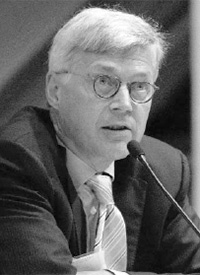
Scott D. Sagan
Scott D. Sagan is the Caroline S.G. Munro Professor of Political Science, Senior Fellow at the Freeman Spogli Institute, and Codirector Emeritus of the Center for International Security and Cooperation at Stanford University. He was elected a Fellow of the American Academy in 2008 and serves as Codirector of the Academy’s Global Nuclear Future Initiative.
When Academy President Leslie Berlowitz came to my Stanford office a number of years ago to ask whether I would be interested in sharing the leadership responsibilities for an Academy project looking at the nuclear future, I pulled out the pathbreaking 1960 issue of Dædalus on arms control off my shelf. Several influential scholars and policy-makers – Hubert Humphrey, Henry Kissinger, Thomas Schelling, Paul Doty – were involved with that extraordinarily important issue. It was called “the bible of arms control” by John F. Kennedy, and it created arms control as a legitimate topic for both scholarly analysis and government consideration. The 1960 Dædalus issue was the first major publication to argue that it was in the United States’ interest for the Soviet Union to have invulnerable second-strike nuclear forces, because then the Soviets would be less fearful of an American attack and might be willing to have some constraints on their behavior and their nuclear forces. This was a conceptual innovation and, eventually, contributed to a significant policy breakthrough.
That issue also created a tradition of Academy projects and publications related to arms control and the nuclear future. A Dædalus issue from 1975, “Arms, Defense, and Arms Control,” showed how arms control had become part of the American defense policy establishment; the United States had developed an arms control branch of the State Department, for example. Many of the same authors from the 1960 issue contributed to this new volume, but the focus was on integrating defense policy with arms control. By 1991, the Soviet Union had collapsed, and the Academy devoted an issue to looking back on thirty years of arms control: “Arms Control: Thirty Years On.” The issue marked the first time that non-Americans were invited to comment on this topic in Dædalus, and it contained a great deal of historical reflection: what the role of arms control had been, and what it should be in the future.
In 2009–2010, our project produced two volumes of Dædalus, not on arms control in the traditional sense of Russian-American arms control or Chinese-American nuclear arms control, though those topics are still important. Instead we focused on what we see as the even more important question for the global nuclear future. That is, can we have the spread of nuclear energy to more countries, or expansion within countries that have it already, without also creating security challenges related to nuclear weapons, nuclear proliferation, nuclear terrorism, or nuclear safety? Our project believed that thinking through that problem and identifying some potential solutions would be very valuable. So we assembled a group of international voices – from France, Egypt, Brazil, Iran, Sri Lanka, Russia, Japan, and America – to debate these issues. It is a diverse group not only in terms of profession or discipline – we have social scientists, scientists, businessmen, diplomats, leaders of international organizations, and politicians – but also in terms of the range of perspectives. Thomas Schelling, for example, argues in the first of the two issues that getting rid of nuclear weapons would be a very bad thing, creating conditions that would allow for a conventional World War III. In that same issue, Sam Nunn argues quite the opposite position: that doing away with nuclear weapons in a verifiable manner would be extraordinarily important to produce more security for both the United States and other nations.
The Dædalus volumes have been just one part of our effort to reach out to international audiences and to policy-makers, both domestic and international. The project has been equally active in promoting global discussions and dialogues about how best to reduce nuclear risks. For example, in May 2010 the Academy, along with Carnegie Corporation of New York, brought together past and current diplomats dealing with global nuclear issues to meet with our project leaders during one of the lunch breaks at the Nuclear Non-Proliferation Treaty (NPT) Review Conference at the United Nations. The meeting, which included Libran Cabactulan, President of the 2010 NPT Review Conference, gave us an opportunity to discuss what the NPT means today and how it can be improved.
Safety, Security, and Safeguards for Nuclear Energy
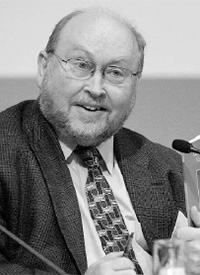
Steven E. Miller
Steven E. Miller is Director of the International Security Program at the Belfer Center for Science and International Affairs at the Harvard Kennedy School. He was elected a Fellow of the American Academy in 2006 and serves as Co-director of the Academy’s Global Nuclear Future Initiative. He is also Cochair of the Academy’s Committee on International Security Studies.
On March 11, 2011, a massive earthquake off the northeast coast of Japan triggered an enormous tsunami that exceeded the design parameters of the Fukushima Daiichi Nuclear Power Plant, located near the coast. The plant was swamped and lost complete power for a protracted period of time. This outage led to a loss of cooling, which caused the heat build-up that subsequently produced hydrogen explosions, radioactivity releases, core meltdowns, and so on. Though the earthquake and tsunami caused a vast human tragedy, there was almost no direct loss of life from the nuclear accident. It was, however, massively disruptive and resulted in fifty-mile or more evacuation zones (including some areas that will be uninhabitable for some time to come), huge losses of energy, significant decreases in economic activity, and massive cleanup costs. The aggregate impacts of the Fukushima accident are estimated to measure in the hundreds of billions of dollars.
It will be some time before all the details of this experience are fully gathered and understood, but the story that is emerging seems to suggest that the fundamental problems involved unwise design choices, poor decisions about safety criteria, and considerable management and regulatory failures by the responsible parties in Japan. The Fukushima experience vivifies the set of issues that we are trying to address in the Academy’s Global Nuclear Future Initiative. It reminds us of a fundamental question: how can humankind manage this technology in a way that harvests the benefits of nuclear power while avoiding the potential adverse risks and consequences? Keep in mind that Japan has a mature, sophisticated nuclear sector; this was not some neophyte struggling to deal with the accident. Nevertheless, by virtue of the various governance arrangements for handling the nuclear industry in Japan, it was not only the reactors that were overwhelmed by the tsunami but also the human capacity to respond.
We live in a world with 440 nuclear reactors distributed across approximately 30 countries. The most recent reactor to go live, subsequent to Fukushima, was in Iran in May 2011, at a place called Bushehr. Iran is merely the spearhead of a much wider phenomenon. In the last half-dozen years, more than 60 additional states have approached the International Atomic Energy Agency (IAEA) expressing serious interest in pursuing nuclear power. If you take the aggregate pipe dreams of every nation that is thinking about nuclear power, several decades down the road we could be living in a world where nuclear power is much more widely distributed, including in a number of countries that are new to nuclear power. But even if many nuclear dreams never come true, we are almost certain to witness a substantial spread of nuclear power to additional countries. The global nuclear landscape is changing.
This scenario raises the question of whether the governance arrangements we have for managing nuclear power on a global scale are adequate today, and whether they will be sufficient for the future. The additional stress that could arise from the growth and expansion of nuclear power is one of the things that has animated our project. Fukushima is a wrinkle in the sense that it will probably slow and constrain the future growth of nuclear power; but Scott and his team at Stanford have been monitoring the situation very closely, and the reality is that most of the states that are seriously interested in pursuing nuclear power have explicitly articulated an intention to move forward, despite Fukushima, for a variety of reasons.
Our project is looking at safety issues, fuel cycle management issues, and the nonproliferation implications of the large-scale spread and expansion of nuclear power around the world. We are thinking about ways to improve or adjust the collective governance mechanisms that currently exist to manage the global nuclear order. We held a workshop in August 2010 called Game Changers for Nuclear Energy; we considered the potential for a large-scale accident and what that might mean for the trajectory of nuclear power. We are undertaking significant policy outreach, not only in the United States but also with the IAEA, the World Institute of Nuclear Security, the Arab League, and the Association of Southeast Asian Nations. We are working hard to ensure that our project’s voice is heard in the debate over how to build appropriate structures to buffer against the Fukushima-like possibilities that could arise in relation to nuclear power.
Safety, Security, and Safeguards for Nuclear Energy
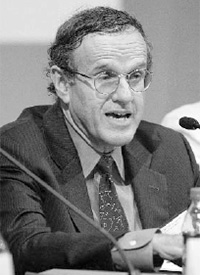
Robert Rosner
Robert Rosner is the William E. Wrather Distinguished Service Professor in the Departments of Astronomy and Astrophysics and Physics at the University of Chicago, where he also serves as Founding Director of the Energy Policy Institute at Chicago (EPIC). He was elected a Fellow of the American Academy in 2001 and serves as a member of the Academy’s Council. He also serves as Senior Advisor to the Academy’s Global Nuclear Future Initiative.
The Fukushima disaster happened when we were in the process of planning a project workshop on nuclear energy to be held in Chicago. We reconfigured the workshop to respond to the disaster, and here the convening power of the Academy really mattered. We gathered an international group of experts, including of course the Japanese. A very important element of our project that both Scott and Steve alluded to is a belief that in the nuclear arena in particular, the time for America to lecture the rest of the world has long passed. In fact, for us to be effective in the work that we do, it is essential that we have the kind of international, multidisciplinary, cross-institutional conversations that are the hallmark of this project and of the work of the Academy in general.
There is still much to be learned about what happened at Fukushima, but some lessons are already clear. One lesson has to do with the role of the operator and the regulator. When dealing with critical technology (that is, technology where the downside risks can be enormous) under emergency conditions, decisions by on-site operators, taking into account site-specific emergency plans, must take precedence. Yet in the case of Fukushima, there was wrangling between the on-site staff and senior TEPCO> executives back in Tokyo. For example, the issue was whether the on-site staff should be allowed to vent the main pressure vessels of the reactors. The folks in Tokyo said no, likely for political reasons. It is arguable that the lack of venting early on contributed to the hydrogen explosions that led to much greater radioactivity releases than would have happened if the pressure vessels had been vented.
Several questions arise: How did the operators come to this point? Where was the regulator? What is the relationship between the regulator and the operator? It has become clear that despite the fact that Japan has an extremely well-developed nuclear sector from a technical point of view, it is underdeveloped from the human factor viewpoint. Japan had not implemented the lessons learned from accidents such as Three Mile Island – namely, that the (government) regulator must be independent of both the operator and the government promoter of the regulated industry.
There is also the question of how to take humans out of the command chain under conditions where speed of response is of the essence. The aircraft industry, for example, has designed planes so that if a plane enters stall conditions, automatic systems respond first. (It is interesting to note that the recent Air France disaster over the Atlantic was a case of the operators, the pilots, fighting the automatic system, to bad effect.) Can that kind of thinking, whereby humans are removed from the emergency response system wherever possible, be a guiding light for the nuclear industry worldwide? It is our hope as a group, working with our international colleagues, that the nuclear industry will move aggressively to a world where the human factor – the relationship between the regulator and the operator – is clarified and engaged in a sensible way.
© 2012 by Neal Lane, Keith Yamamoto, Linda P.B. Katehi, Leah Jamieson, John D. Steinbruner, David D. Clark, Don M. Randel, Richard H. Brodhead, Steven Knapp, Diane P. Wood, David J. Skorton, Kelly Sims Gallagher, Robert W. Fri, Scott D. Sagan, Steven E. Miller, and Robert Rosner, respectively
To view or listen to the presentations, visit http://www.amacad.org/events/Induction2011.